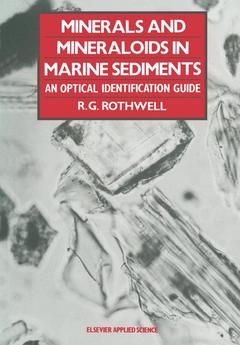Minerals and Mineraloids in Marine Sediments, Softcover reprint of the original 1st ed. 1989 An Optical Identification Guide
Langue : Anglais
Coordonnateur : Rothwell R.G.

Over 60% of the Earth's surface is covered with deep marine sediments, however, until the early 1980s, no comprehensive text books appeared to support the rapid expansion in the study of these sediments. While the whole field of marine geology has expanded enormously and entirely new disciplines, such as paleoceanography, have been developed, there remains a lack of reference texts on study techniques that investigators in the marine community can turn to. Minerals and Mineraloids in Marine Sediments is an optical identifica tion guide that I believe will become a standard reference text for use in the microscope analysis of marine sediment& and sedimentary rocks. The systematic collection of sediment cores from the deep ocean floor began in earnest with the Swedish Deep Sea Expedition, 1947-1948. Much of the microscopic examination of the sediments collected in these piston cores (10 m+ long) was conducted on separated grain mounts or thin sections of impregnated sediments. By the late 1960s a simpler technique of examining a mounted smear of the cored silt and clay size sediment on a microscope slide had become standard practice in American oceanographic institutions. This semi quantitative technique became the standard tool used in core description aboard Glomar Challenger through the 15 years of the Deep Sea Drilling Project (DSDP), 1968-1983. Visual percentage estimates of biogenic and mineral components were made using petrologic micro scopes.
I.- The mineralogy of marine sediments.- The composition of marine sediments.- Sediment classification.- Distribution of sediment types.- The abundance of minerals in marine sediments.- The smear slide method.- II.- Minerals and Mineraloids Occurring in Marine Sediments.- Explanatory Notes.- Aragonite.- Barite.- Calcite.- Clay.- Dolomite.- Feldspar.- Ferromagnesian minerals.- Amphiboles.- Olivine.- Pyroxenes.- Glauconite.- Gypsum (and anhydrite).- Heavy minerals.- Andalusite.- Apatite.- Cassiterite.- Epidote.- Garnet.- Kyanite.- Monazite.- Rutile.- Sillimanite.- Sphene (titanite).- Staurolite.- Tourmaline.- Zircon.- Iron Oxides.- Haematite.- Ilmenite.- Limonite.- Magnetite.- Mica.- Micronodules (Fe-Mn oxides and hydroxides).- Palagonite.- Pyrite.- Quartz.- Volcanic glass.- Zeolites.- Clinoptilolite.- Phillipsite.- Native elements.- Extraterrestrial material in marine sediments.- References.- Appendices.- Appendix 1: Glossary of descriptive terms used in the text.- Appendix 2: Comparative percentage charts for estimating proportions of sedimentary components.- Appendix 3: Suggested format for a smear slide descriptor form.- Appendix 4: Flow charts for the identification of mineral grains seen in smear slides.- Appendix 5: An illustrated key to the identification of the main microfossil groups.
Date de parution : 09-2011
Ouvrage de 282 p.
17x24.4 cm
Disponible chez l'éditeur (délai d'approvisionnement : 15 jours).
Prix indicatif 116,04 €
Ajouter au panierThème de Minerals and Mineraloids in Marine Sediments :
Mots-clés :
© 2024 LAVOISIER S.A.S.



